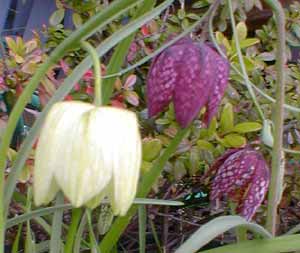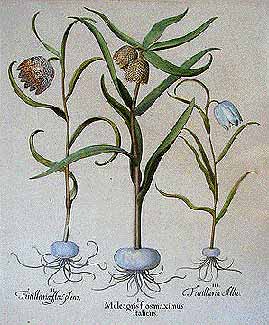
White Snake's-head; or,
Albino Missionbells; or,
'Alba' Checkered Lily
The classic Hortus Eystettensis by Basil Besler (1561-1629) was published in Nuremburg in 1613. It included among its hand-tinted copperplate engravings a page (shown below) depicting what Besler called Meleagris flos maximus which is today known as Fritillaria meleagris, & flanked the portrait with two naturally occurring variants, these being labeled "Fritillaria flore pleno" (a double-flowered form) & "Fritillaria Alba," the white form.
The albino Snake's-head or Checkered Lily has been known to gardening for as long as the regular kind. It commonly crops up in any purchase of regular Checkered Lilies bulbs. We planted many regular bulbs for this European meadow flower, & ended up by happenstance with a single white-flowering specimen in a morning-sun location below an akebia trellis, amidst the regulars.
 It is sometimes possible to buy just 'Alba' separately, & we may do so next autumn. Both forms of F. meleagris possess the Award of Garden Merit for beauty, ease of growth, & for having long proven themselves as desirable garden standards. Some people regard them as prettier than regular checkered lilies. I like the strangely netted pattern of the basic Checkered Lily more than just about any fritillary that exists, but if I were to select two that were almost as nice, one would be 'Alba,' the other would be F. michailowskyi.
It is sometimes possible to buy just 'Alba' separately, & we may do so next autumn. Both forms of F. meleagris possess the Award of Garden Merit for beauty, ease of growth, & for having long proven themselves as desirable garden standards. Some people regard them as prettier than regular checkered lilies. I like the strangely netted pattern of the basic Checkered Lily more than just about any fritillary that exists, but if I were to select two that were almost as nice, one would be 'Alba,' the other would be F. michailowskyi.It grows one foot tall its first year, with only one or two flowers. For its second year & thereafter, it can reach eight inches to two feet, with increasing numbers of flowers.
They are only rarely pure white but have a considerable range & degree of albinism. Sometimes they have a ghost of green webbing to remind one of the checkered pattern of the normal version. Elsetimes they have only the verticle lines of a creamy faint green, but otherwise white or cream colored. Only rarely does a given bulb produce truly & purely white flowers.
Whatever specific flower the bulb produces, its self-cloned bulbs will produce the same flowers in future years. But as it self-seeds, the offspring will be of random appearance from normal checkering to faintly green-checkered white to actual white.
It has no special care requirements distinct from the regular Checkered Lily. It likes sun to part shade, bu more sun is best for the Pacific Northwest. Sharp drainage is a must. In our gardens it is fully in bloom by late March, lasting as late as early May. It can be grown in zones 4 through 8, blooming later in spring in colder zones.
See the page for the regular Checkered Lily for further discussion of the species.